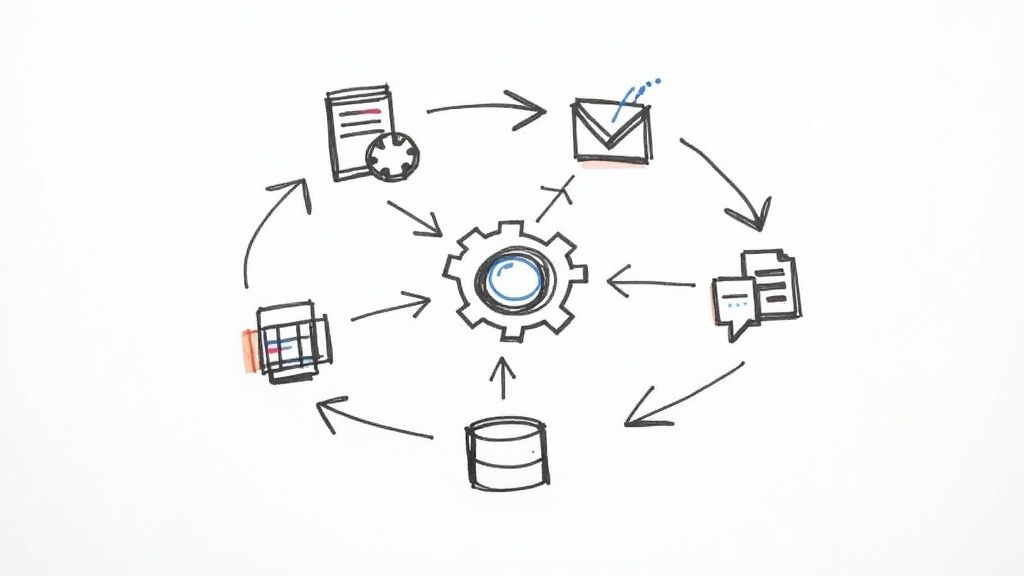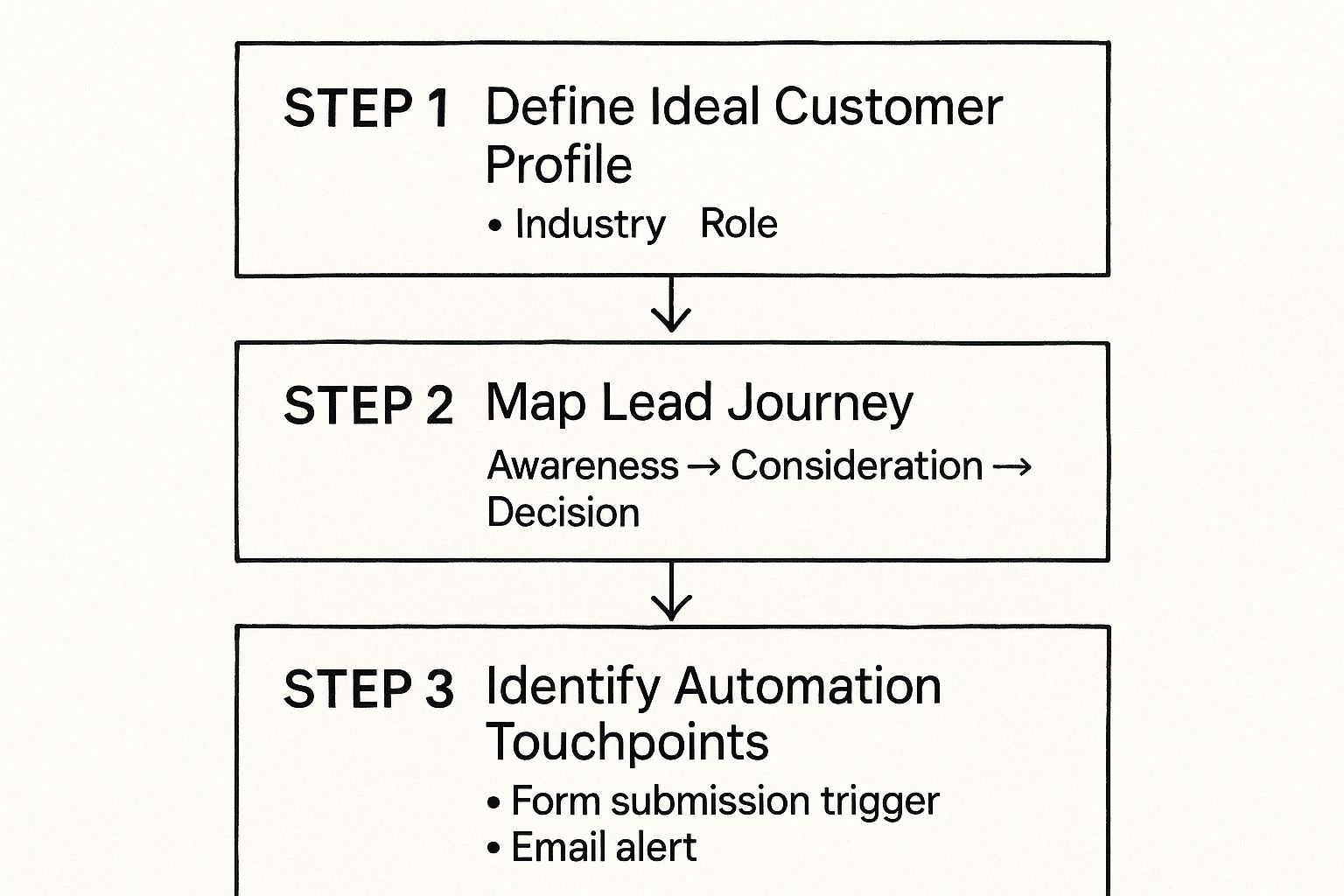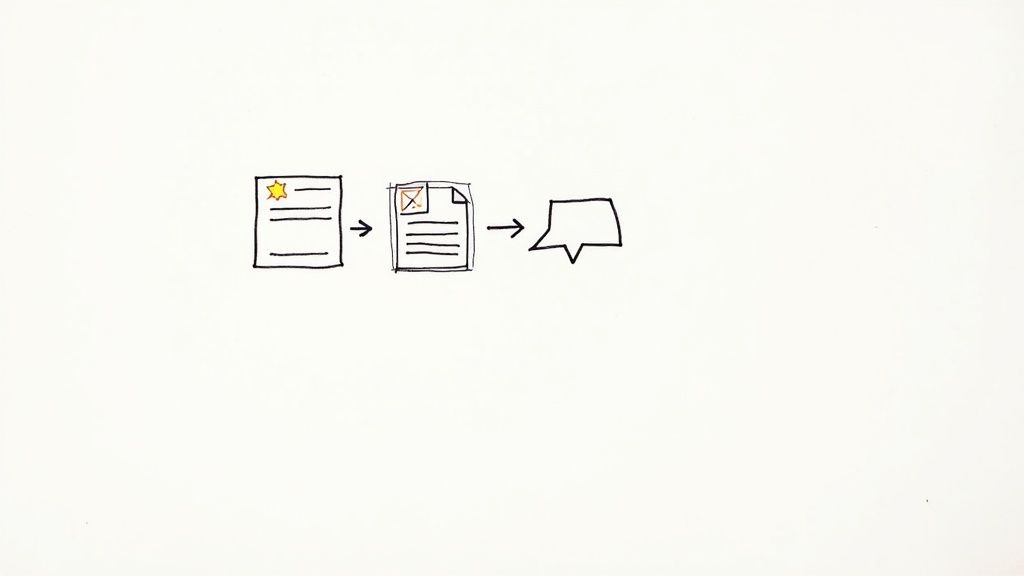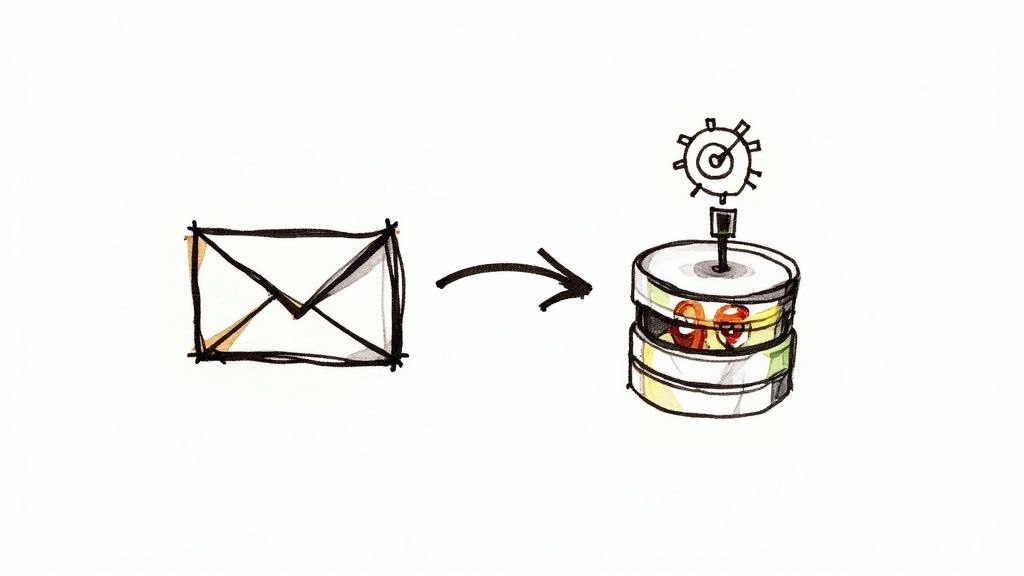How to Automate Lead Generation

Automated lead generation is all about creating a system that captures, nurtures, and qualifies potential customers for you, even while you sleep. Think of it as your best salesperson, working 24/7 to turn casual website visitors into people who are genuinely ready to talk business.
Why Automated Lead Generation Is Now Essential

Let’s be real—the days of chasing down every new lead by hand are long gone. Trying to manage everything with spreadsheets and sticky notes isn’t just inefficient; it’s a surefire way to miss out on deals and hit a growth ceiling. In a world where people expect an answer now, a manual process can kill a sale before it even begins.
Picture this: someone fills out a contact form on your website late on a Friday night. With a manual setup, that lead just sits there, gathering dust in an inbox until Monday morning. By that time, they’ve likely already moved on and found a competitor who got back to them instantly. That delay isn’t just a minor inconvenience; it tells your potential customer that you aren’t quite ready for them.
The High Cost of Manual Management
The problem goes way beyond slow response times. Manually handling leads eats up your most precious resource: your team’s time. Instead of building relationships and closing deals, your best people get stuck doing repetitive admin work like data entry, sending basic follow-up emails, and setting calendar reminders.
This inefficiency hits your bottom line, hard. Customer acquisition costs are always on the rise, making every single lead more valuable than ever. Letting a good prospect slip through the cracks because of a forgotten follow-up or a simple human error is a mistake most of us can’t afford to make.
Automation flips the script. It turns your lead management from a reactive, time-consuming chore into a proactive, scalable engine for growth. Every lead gets the right attention, right away.
To really see the difference, let’s compare the old way with the new way.
Manual vs Automated Lead Generation At a Glance
Here’s a quick look at how a manual process stacks up against an automated workflow powered by a tool like Sagekit. The contrast in efficiency and scalability becomes pretty clear.
| Aspect | Manual Process | Automated Process (with Sagekit) |
|---|---|---|
| Response Time | Hours or days, depending on availability. | Instantaneous, 24/7 engagement. |
| Lead Nurturing | Inconsistent, often forgotten. | Systematic, personalized email sequences. |
| Scalability | Limited by team size and hours in the day. | Infinitely scalable without adding headcount. |
| Data Accuracy | Prone to human error (typos, missed fields). | Consistent and accurate data transfer. |
| Cost | High labor costs for repetitive tasks. | Low operational cost; frees up team for high-value work. |
The takeaway is simple: automation lets you do more with less, ensuring no opportunity is wasted.
The Shift to Digital and Its Demands
The way we sell has changed for good. With 80% of B2B sales interactions now happening in digital channels, automation isn’t just a nice-to-have; it’s a core part of the playbook. The numbers don’t lie—companies using smart tools for lead generation see a 50% increase in sales-ready leads and cut their costs by as much as 60%. If you’re curious, you can discover more about these targeted lead generation trends and dig into the data yourself.
A well-built automated system, like the ones you’ll create with Sagekit, works tirelessly behind the scenes. It captures lead info, qualifies interest, nurtures relationships, and sends hot leads straight to your sales team. This is no longer a luxury for big companies—it’s a fundamental tool for any business looking to grow.
Laying the Groundwork for Your Automation Engine
https://www.youtube.com/embed/3NchPj1rO24
Before you even think about building your first workflow, you need a solid blueprint. I’ve seen it time and time again: people jump straight into the tools without a clear plan, and it just gets messy. A successful automation engine is built on a foundation of solid strategy, not just fancy tech.
The first, and honestly most critical, step is to get crystal clear on who you’re trying to attract. Without a detailed Ideal Customer Profile (ICP), your automated messages will feel generic and fall flat. An ICP isn’t just a vague idea of a customer; it’s a specific, documented definition of the perfect fit for your business, right down to their industry, company size, and specific job title. Getting this right ensures every automated touchpoint speaks directly to the person who needs to hear it.
Charting the Customer Journey
Once you know who you’re targeting, the next step is to map out how they actually become a customer. This means visualizing their entire journey, from the very first time they hear about your brand to the moment they sign on the dotted line.
When you understand this path, you start to see the exact moments where automation can have the biggest impact.
Think about it: a key touchpoint is right after someone downloads an ebook or a whitepaper. That’s a high-intent signal! An automated, personalized follow-up at that exact moment can make all the difference. Mapping the journey helps you move beyond just automating basic tasks and start thinking strategically about what true workflow automation can do for your sales pipeline.
This process is all about connecting your ideal customer profile to specific, high-leverage automation triggers.

As you can see, a strong strategy directly informs where and how you should apply technology for the best results.
Assembling Your Toolkit
With a clear ICP and a well-defined journey map in hand, it’s time to gather the right tools for the job. For the workflow we’re building in this guide, our automated system will rely on a few key components working in harmony.
Here’s the stack we’ll be using:
- Sagekit: This is the brain of our entire operation. It’s the platform that will connect all our apps and execute the automated workflows we design.
- Google Sheets: We’ll use this as a simple but powerful database to log every new lead captured from our website forms.
- Slack: This is for instant notifications. It ensures your sales team knows about a hot new lead in real-time so they can act on it immediately.
- Your CRM: This is the final destination for qualified leads, where your sales team can take over and manage the relationship.
By defining your target and mapping their journey first, you ensure your technology serves your strategy—not the other way around. This foundational work is the difference between an automation that just runs and one that truly drives results.
While you’re laying the groundwork, you might also consider solutions for automating content creation to keep your lead generation funnels fed with fresh material. Each tool plays a specific role, but it’s Sagekit that orchestrates the entire process, turning a bunch of separate tasks into a seamless, intelligent system.
Now, let’s start putting these pieces together.
Building Your First Lead Capture Workflow

This is what it looks like inside Sagekit—a clean, visual way to connect a trigger (like a new row in a Google Sheet) to a specific action. You can literally see how your automated lead generation system is being built, piece by piece. It’s pretty intuitive.
Okay, with the strategy mapped out and our tools ready, it’s time to get our hands dirty. This is the fun part, where you see just how quickly you can turn an idea into a working process. We’ll start with a simple but powerful workflow that almost every business needs: automatically capturing a new lead from a website form and letting the team know about it, instantly.
The whole point here is to kill manual data entry and slash those communication delays. Think about what happens now. A potential customer fills out your “Contact Us” form, and that lead just… sits in an email inbox. We’re going to build a workflow that, the second a lead comes in, automatically does two things:
- Logs the Lead: It will instantly add the contact’s details—name, email, company, etc.—to a dedicated Google Sheet.
- Alerts the Team: It will fire off a real-time notification to a specific Slack channel, telling your sales team a hot lead just landed.
This isn’t complicated, but it’s the foundation of a responsive and organized system. You get accurate data capture every single time, and your team can jump on new opportunities while the prospect’s interest is still red-hot.
Setting Up Your Data Hub in Google Sheets
First things first, let’s create the destination for our lead data. Head over to Google Sheets and start a new spreadsheet. I always name mine something obvious to avoid confusion later, like “Website Leads Q4 2024”.
Now, create the column headers for the info you’re capturing from your form. A solid starting point usually includes:
TimestampFull NameEmail AddressCompany NameMessage
This simple structure creates a clean, organized log of every single inquiry. I find the Timestamp column especially useful for spotting patterns in when your best leads are coming in. With this done, your Google Sheet is officially ready to act as your lightweight, always-accessible lead database.
Configuring the Slack Notification
Next up, we need a place for the alerts to go. Pop over to Slack and create a new channel—it can be public or private, whatever works for your team. My advice? Name it something unmistakable, like #new-leads or #sales-alerts. This prevents your crucial lead notifications from getting buried in a noisy general channel.
By setting up a dedicated channel, you’re giving your sales team a clear signal. When a message pops up in #new-leads, they know it’s a priority that needs immediate attention. This simple change can make a massive difference in your team’s response time.
A fast response is a huge competitive advantage. I’ve seen studies showing that getting back to a lead within the first five minutes can boost conversion rates by an incredible 900%. This workflow makes that kind of speed automatic.
So now our endpoints are ready to go in both Google Sheets and Slack. We’ve built the foundation. The next step is to use Sagekit to connect everything, making it the central nervous system for our automated lead generation machine. We’ll tell Sagekit what to watch for—a new form submission—and exactly what to do the moment it happens.
Adding Smart Nurturing and CRM Integration

We’ve laid the groundwork for capturing leads, which is fantastic. But let’s be honest, capturing a name and email is only half the battle. The real work—and where the money is made—starts now. It’s time to add the intelligence that transforms a simple contact into a real sales opportunity.
This is where we go from a basic data-entry machine to a smart, proactive nurturing system. We’re going to layer in two critical components: an instant, automated welcome email and a seamless handoff to your CRM. The goal is to create a closed-loop system that engages leads immediately and gives your sales team everything they need without any manual busywork.
Triggering an Automated Welcome Email
Think about it: the exact moment someone hits “submit” on your form is when their interest is highest. You have to capitalize on that moment. A prompt, relevant first touch can set the tone for the entire relationship.
Inside your Sagekit workflow, right after the Google Sheet and Slack steps, simply add another action. This time, you’ll connect your email provider, whether that’s Gmail, Mailchimp, or another service. Configure it to send a pre-written welcome email using the address captured from the form.
This can’t be just a generic “Thanks, we got your message” email. That’s a missed opportunity. To make it count, be sure to include:
- A personal touch: Use their name in the greeting.
- Immediate value: Link to a genuinely helpful resource, like a relevant blog post or an eye-opening case study.
- Clear expectations: Let them know what happens next and when they can expect a personal follow-up.
An instant, value-driven welcome email does more than just confirm a submission—it demonstrates responsiveness and starts building trust from the very first interaction. It shows you’re organized and ready to help.
The data on this is pretty staggering. Businesses that put this kind of automation in place have seen up to a 451% increase in qualified leads. When you add CRM automation to the mix, you can boost lead conversion rates by as much as 30%. It directly connects your nurturing efforts to the sales pipeline, which is a game-changer.
Integrating with Your CRM for a Single Source of Truth
Now for the final piece of the puzzle: getting this information into your Customer Relationship Management (CRM) system. Manually copying lead data from a spreadsheet into your CRM is a surefire way to introduce errors, lose critical details, and waste valuable time.
For a truly seamless operation where your team has all the customer insights they need, it’s essential to integrate robust CRM solutions like Salesforce. Back in Sagekit, you’ll add one more action to your workflow. This step will automatically create a new contact or lead in your CRM—like HubSpot, Salesforce, or Zoho—populating it with all the data from the form.
This integration creates a single, reliable source of truth for your sales team. Every new lead is logged instantly and accurately, complete with its source and the timestamp.
By connecting these final dots, you’ve built a powerful, hands-off system. It captures, notifies, nurtures, and organizes every single lead, making sure no one ever slips through the cracks again.
So, you’ve launched your first automated workflow. That’s a fantastic first step, but the real work—and the real payoff—is just beginning. Think of your initial setup not as a finished product, but as a solid foundation you can build on.
A great lead generation system isn’t something you just set and forget. It’s an engine that needs constant tuning. The magic happens when you start digging into the data, questioning your assumptions, and doubling down on what’s actually working.
Finding What’s Working (and What’s Not)
First things first, you need to look at the numbers. They tell a story. Are people actually opening your automated welcome emails? Are they clicking the links you put in there? These are the breadcrumbs that lead to better results.
If your open rates are in the gutter, your subject line is probably the culprit. If nobody’s clicking, then your call-to-action or the content of the email itself needs rethinking. Every metric is a signpost telling you where to focus your attention. Don’t be afraid to experiment here.
Running a simple A/B test is one of the quickest ways to learn what resonates. Pit two different subject lines against each other and see which one wins.
- Subject Line A: “Thanks for getting in touch!”
- Subject Line B: “John, here’s that resource you asked for.”
I’ve seen tiny tweaks like this create massive lifts in engagement. You’ll likely find that a more personal, benefit-focused subject line makes a much stronger first impression.
The best automation is built on a cycle of feedback and improvement. Your data isn’t just a grade—it’s a map showing you where to go next.
How to Scale Beyond the Basics
Once you’ve ironed out the kinks in your main workflow, it’s time to think bigger. Scaling doesn’t just mean cramming more leads into the same funnel. It means creating smarter, more relevant experiences for different segments of your audience.
Someone who attended your webinar is in a completely different headspace than someone who just downloaded a whitepaper. Trying to treat them the same is a missed opportunity. This is where you can use Sagekit’s conditional logic to create unique journeys for each lead source.
For example, you could easily set up different paths:
- Webinar attendees could get a follow-up email with the slide deck and an invite to a private Q&A.
- Whitepaper downloaders could get a follow-up a few days later with a related case study.
- “Contact Us” submissions could be flagged as high-intent and trigger an instant Slack notification for your best sales rep.
This kind of segmentation makes your automation feel less like a machine and more like a helpful, personal interaction. And the numbers back this up—AI-driven personalization has been shown to improve conversion rates by as much as 10%.
By building out these specialized workflows and continuously testing your approach, you move from a simple, linear process to a dynamic lead generation engine that truly drives growth.
Your Top Automated Lead Generation Questions, Answered
As you start piecing together your first automated lead generation workflows, you’re bound to have some questions. That’s perfectly normal. Getting the right answers early on is the best way to build a system that works and avoid common pitfalls. Let’s tackle a few of the big ones I hear all the time.
How Do I Stop My Automated Emails from Sounding Like a Robot?
This is a classic concern. The trick isn’t just dropping in a {{first_name}} token and calling it a day. Real personalization comes from two things: relevance and timing.
The most powerful thing you can do is trigger your automations based on what a lead just did. An email that arrives moments after someone downloads an ebook feels helpful and timely, not creepy or robotic.
In Sagekit, you can easily use tokens for names and company details, but your real focus should be on writing copy that connects with their immediate needs. Keep your tone conversational and helpful. It’s far better to be a genuinely helpful “bot” than a human trying to pretend they’re writing every single email by hand.
My personal rule of thumb: Don’t try to hide that it’s an automated email. Instead, make it so useful and timely that the person is genuinely glad the automation sent it. That’s the real win.
What are the “Must-Track” Metrics?
It’s so easy to get bogged down tracking things like email open rates. While interesting, they’re often just vanity metrics. They don’t tell you if your system is actually bringing in revenue.
You need to focus on the numbers that directly impact your bottom line. I always recommend zeroing in on these three:
- Lead-to-Customer Conversion Rate: This is the big one. How many of the leads your automation brings in actually become paying customers?
- Cost Per Acquisition (CPA): Are you getting customers more efficiently? This metric tells you if your automation is more cost-effective than your old, manual processes.
- Sales Cycle Length: Is your workflow helping the sales team close deals faster? Shaving days or weeks off this cycle is a massive efficiency gain.
These KPIs give you a crystal-clear view of the real-world value your system is creating. They show you exactly where to tweak things to get a better return on your effort.
Can I Actually Do This on a Shoestring Budget?
Yes, you absolutely can. The idea that automation is only for big companies with massive budgets is a total myth. Modern tools are built to be affordable and scalable.
With a platform like Sagekit, you can get started on a free plan and connect the tools you’re probably already paying for, like Google Sheets or your email provider.
Think about the first workflow we built in this guide—the one that grabs lead info and sends a Slack notification. That costs practically nothing to run, yet it can easily save your team hours of tedious data entry every single week. Start with a small, high-impact workflow, prove its value, and then you can scale up your efforts with confidence.
Ready to stop chasing leads and start building a reliable growth engine? Sagekit makes it easy to connect your tools and automate workflows in just a few minutes. Build your first automated lead generation system for free and see how you can save 10+ hours every week.